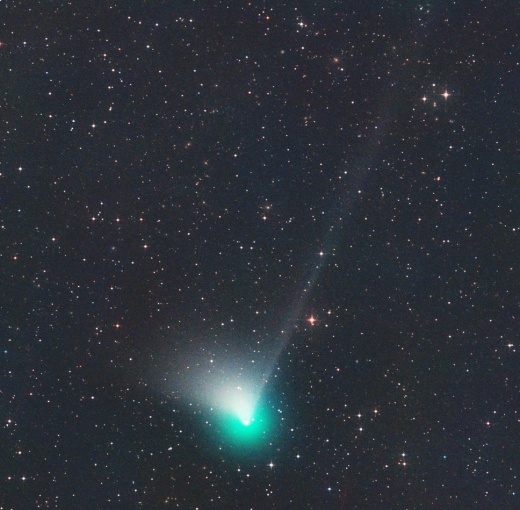Comet E3 ZTF Brightens as the First Good Comet of 2023
By David Dickinson
The first good comet of the year, Comet E3 ZTF is a fine object for northern hemisphere observers in January.
As in years previous, 2023 kicks of with another descent binocular comet.
If you haven’t seen C/2022 E3 ZTF yet, you’ll soon have your chance. Discovered by the Zwicky Transient Survey searching for supernovae, E3 ZTF was first spotted as a +17th magnitude object gliding through the constellation of Aquila the Eagle on the night of March 2nd, 2022.
As of writing this, the comet is shinning at magnitude +7 in the constellation Corona Borealis. This currently places it low to the northeast for northern hemisphere observers in the early morning hours. The good news is, the view improves in late January into early February, as the comet heads towards circumpolar (much like Comet C/1995 O1 Hale-Bopp did in the winter of 1996-1997) and stays above the horizon all night.

With a high 109 degree orbital inclination relative to the ecliptic plane, Comet E3 ZTF is on an estimated ~50,000 year (inbound) orbit.

We’re already seeing some amazing images of the comet online as it nears the Earth. Here’s a month-by-month break down of celestial dates with destiny for Comet C/2022 E3 ZTF:
(Unless otherwise noted, ‘near’ means less than one degree apart)

January
12th – Reaches perihelion at 1.1 Astronomical units (AU) from the Sun.
14th – Crosses into Boötes.
22nd – Crosses into Draco.
23rd – passes 2 degrees from the galaxy M102.
24th – Passes near the +3.3 magnitude star Edasich (Iota Draconis), and reaches opposition.
25th – Passes into Ursa Minor.
28th – Crosses into Camelopardalis.
29th – Passes less than 10 degrees from the north celestial pole.
30th – Nicks the border edge of the constellation Draco, passing back into Camelopardalis.

February
1st – Passes 0.28 AU (150 million kilometers) from the Earth, moving at an apparent 6 degrees per day across the sky.
2nd – May top out at +5th magnitude.
4th – Passes into Auriga.
5th – Passes less than 2 degrees from Capella.
6th – Threads through the stars Almaaz (Epsilon Aurigae) and Hoedus 1/II (Eta Aurigae).
7th – crosses the galactic equator southward.
8th – passes Hassaleh (Iota Aurigae).
9th – crosses into Taurus.
11th – Photo Op: Passes near the planet Mars.
12th – Crosses the ecliptic southward.
14th – Passes 2 degrees from the Hyades and Aldebaran.

March
4th – Crosses the celestial equator southward, into the constellation Eridanus.
15th – May drop back below +10th magnitude.
Binoculars are your best bet for observing comet E3 ZTF: simply sweep around the suspect field and look for a fuzzy ‘star’ that refuses to snap into focus. To my eye, many fuzzball comets look like indistinct, unresolved globular clusters… legend has it was this very fact that moved 18th century comet hunter Charles Messier to compile the first deep sky catalog, as a way to mark these fixed ‘false comets’ in the sky.
2022 was an interesting year for comets: 73 (non-sun-grazing) comets were discovered in 2022, 16 of which were named after people, and 57 were named after automated sky surveys (think PanSTARRS, ZTF, etc) or combinations thereof. The Solar Heliospheric Observatory (SOHO) alone discovered an additional 191 new sungrazing comets in 2022, bringing the mission tally to 4,551 comets and counting over its 27-year mission span. Most of these are typically found by online volunteers.
…And there are about a dozen comets to watch for in 2023. Speaking of SOHO, Comet 96P Machholz should put on a good show, as it passes through SOHO’s outer LASCO C3 field of view in late January early February.
If skies are clear, be sure to brave the cold and check out Comet C/2022 E3 ZTF this winter.
The post Comet E3 ZTF Brightens as the First Good Comet of 2023 appeared first on Universe Today.

January 9, 2023 at 04:11PM
via Universe Today read more...

Post a Comment